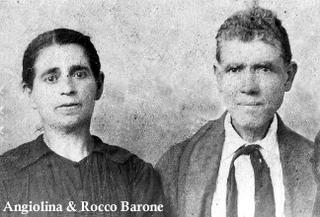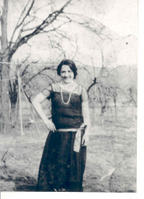Bruno Comes to America
by Jennifer Rowell
from interviews from Bruno & Jennie

Bruno Barone was born on June 8, 1895 to Rocco Barone and Angiolina Barone in Palmi, Reggio Calabria, Italy. Bruno was born during the great wave of southern Italian emigration to North America (1880-1924). He was the second of nine children.
Located at the “toe of the boot”, Palmi was a city of about 14,000 people during Bruno’s childhood. The house that Bruno grew up in was small, like a shed. The children slept in the upstairs loft, while Angiolina had a general store in one part of the main floor of the house. Bruno’s mother sold baccala, wine, olive oil, figioli, chici, lentils,and pasta. There were two bedrooms and a small kitchen downstairs opposite the store. In the back of the house was a stable for the family donkey. The house was made of wood. Rocco worked in the mountainous fields of Palmi called the campagnia.
Typically children went to school to the third grade. Bruno’s parents wanted their children to learn more, but there wasn’t a lot of opportunity for better jobs or a better life in Palmi during the early years of the twentieth century. Bruno probably attended school long enough to learn how to read and write, then spent his middle childhood years helping his father farm in the campagnia.
Bruno was a playful, gentle, hardworking boy who entered the Italian Army at the age of 15. He served for a year and then reentered the service for another five years. During this time Rocco and Angiolina were informed that Bruno had died three different times! Then one day Bruno mysteriously reappeared! He never elaborated about his time in the military service. Years later his family discovered that he had saved his platoon from the enemy during World War I and was awarded several medals for bravery!

Angiolina watched her son return to the campagnia after the war with a heavy heart. She didn’t want him to waste his life working hard with little or no possibility for economic and social growth. One day she showed him a picture of a beautiful, young American girl-Vincenza “Jennie” Pugliese. She said, “You are going to have to marry this one!” Bruno looked at the picture and said, “Ma! I could never marry her! She is fancy! She has a hat on!” Bruno refused to leave his family for America. Instead he stayed in Palmi for a few more years to help contribute income to his parents’ household. Angiolina kept writing to Jennie’s family and never forgot her dream of a better life for Bruno.
Finally, in October of 1922, Bruno decided it was time to file his papers at the immigration station. He asked a clerk at the immigration station, “How long will I be on the waiting list.” The clerk replied, “Someone backed out today! Pack your bags!” Bruno frantically called his family from the train station. They packed wine, chichi, cheese, and extra supplies into bags and rushed to the train. They arrived just as the train was leaving. Bruno’s parents and siblings stuffed his bags through the window of the moving train. Bruno never saw his parents again. Two years after he left Palmi, Rocco died. Angiolina died eleven years after Rocco.
Once in Naples, Bruno began the rigorous preparation for sailing to America. He was probably given an antiseptic bath and quarantined for 5 days to insure that he didn’t have any communicable diseases before he boarded the S.S. Taormina. He was probably given a short haircut while he was detained in Naples. The health officials inspected him and probably gave him vaccinations. After all of the exams were completed, he was ushered to the boarding dock and provided additional information for the Taromina’s ship manifest.
Bruno left Naples on November 12, 1922. He probably wandered freely along the steerage deck listening to singing, mandolin playing, or storytelling, watching card games or dancing. The New York Times noted that the North Atlantic was experience gales, winds, and now flurries during this time. He may have spent a large part of the trip locked in the steerage compartment of the Taromina. Bruno arrived in New York Harbor on November 24, 1922. He spent the about five hours of the next day being processed through Ellis Island. After passing the inspection at Ellis Island, a Good Samaritan asked Bruno where we was traveling. Bruno pulled out a scrap of paper from his jacket, which read, Francesco Pugliese, Rockland Lake, Congers NY. The Good Samaritan showed Bruno which train to take and soon he was enroute to the next chapter in his life. He would finally meet the fancy young woman who had captivated his mother’s attention. He was on his way to reunite with the Pugliese clan that had left Palmi thirteen years earlier. He was on his way to Jennie and a new life
by Jennifer Rowell
from interviews from Bruno & Jennie

Bruno Barone was born on June 8, 1895 to Rocco Barone and Angiolina Barone in Palmi, Reggio Calabria, Italy. Bruno was born during the great wave of southern Italian emigration to North America (1880-1924). He was the second of nine children.
Located at the “toe of the boot”, Palmi was a city of about 14,000 people during Bruno’s childhood. The house that Bruno grew up in was small, like a shed. The children slept in the upstairs loft, while Angiolina had a general store in one part of the main floor of the house. Bruno’s mother sold baccala, wine, olive oil, figioli, chici, lentils,and pasta. There were two bedrooms and a small kitchen downstairs opposite the store. In the back of the house was a stable for the family donkey. The house was made of wood. Rocco worked in the mountainous fields of Palmi called the campagnia.
Typically children went to school to the third grade. Bruno’s parents wanted their children to learn more, but there wasn’t a lot of opportunity for better jobs or a better life in Palmi during the early years of the twentieth century. Bruno probably attended school long enough to learn how to read and write, then spent his middle childhood years helping his father farm in the campagnia.
Bruno was a playful, gentle, hardworking boy who entered the Italian Army at the age of 15. He served for a year and then reentered the service for another five years. During this time Rocco and Angiolina were informed that Bruno had died three different times! Then one day Bruno mysteriously reappeared! He never elaborated about his time in the military service. Years later his family discovered that he had saved his platoon from the enemy during World War I and was awarded several medals for bravery!


Angiolina watched her son return to the campagnia after the war with a heavy heart. She didn’t want him to waste his life working hard with little or no possibility for economic and social growth. One day she showed him a picture of a beautiful, young American girl-Vincenza “Jennie” Pugliese. She said, “You are going to have to marry this one!” Bruno looked at the picture and said, “Ma! I could never marry her! She is fancy! She has a hat on!” Bruno refused to leave his family for America. Instead he stayed in Palmi for a few more years to help contribute income to his parents’ household. Angiolina kept writing to Jennie’s family and never forgot her dream of a better life for Bruno.
Finally, in October of 1922, Bruno decided it was time to file his papers at the immigration station. He asked a clerk at the immigration station, “How long will I be on the waiting list.” The clerk replied, “Someone backed out today! Pack your bags!” Bruno frantically called his family from the train station. They packed wine, chichi, cheese, and extra supplies into bags and rushed to the train. They arrived just as the train was leaving. Bruno’s parents and siblings stuffed his bags through the window of the moving train. Bruno never saw his parents again. Two years after he left Palmi, Rocco died. Angiolina died eleven years after Rocco.
Once in Naples, Bruno began the rigorous preparation for sailing to America. He was probably given an antiseptic bath and quarantined for 5 days to insure that he didn’t have any communicable diseases before he boarded the S.S. Taormina. He was probably given a short haircut while he was detained in Naples. The health officials inspected him and probably gave him vaccinations. After all of the exams were completed, he was ushered to the boarding dock and provided additional information for the Taromina’s ship manifest.
Bruno left Naples on November 12, 1922. He probably wandered freely along the steerage deck listening to singing, mandolin playing, or storytelling, watching card games or dancing. The New York Times noted that the North Atlantic was experience gales, winds, and now flurries during this time. He may have spent a large part of the trip locked in the steerage compartment of the Taromina. Bruno arrived in New York Harbor on November 24, 1922. He spent the about five hours of the next day being processed through Ellis Island. After passing the inspection at Ellis Island, a Good Samaritan asked Bruno where we was traveling. Bruno pulled out a scrap of paper from his jacket, which read, Francesco Pugliese, Rockland Lake, Congers NY. The Good Samaritan showed Bruno which train to take and soon he was enroute to the next chapter in his life. He would finally meet the fancy young woman who had captivated his mother’s attention. He was on his way to reunite with the Pugliese clan that had left Palmi thirteen years earlier. He was on his way to Jennie and a new life

1 Comments:
Jennifer, enjoying re-reading article on Bruno Barone coming to America, and about his father and mother. You paint a very compelling picture with your words about the immigrant experience. Thanks,
uncle Charlie
Post a Comment
<< Home